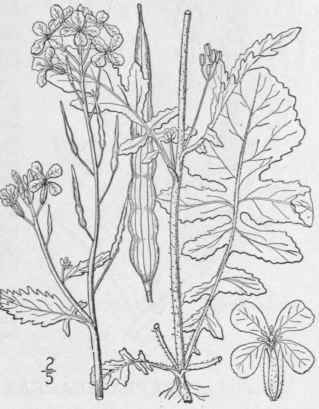43. Raphanus [Tourn.] L. Sp. Pl 669. 1753
Description
This section is from the book "An Illustrated Flora Of The Northern United States, Canada And The British Possessions Vol2", by Nathaniel Lord Britton, Addison Brown. Also available from Amazon: An Illustrated Flora of the Northern United States, Canada and the British Possessions. 3 Volume Set..
43. Raphanus [Tourn.] L. Sp. Pl 669. 1753
Erect branching annual or biennial herbs, with lyrate leaves and showy flowers. Silique linear, coriaceous, fleshy or corky, constricted or continuous and spongy between the seeds, indehiscent. Style slender. Seeds subglobose; cotyledons conduplicate. [Greek, quick-appearing, from its rapid germination.]
A genus of about 6 species, natives of Europe and temperate Asia. Type species: Raphanus sativus L.
Flowers yellow, fading white; pod longitudinally grooved, 4-10-seeded. | 1. | R. Raphanistrum. |
Flowers pink or white; pod not longitudinally grooved, 2-3-seeded. | 2. | R. sativus. |
1. Raphanus Raphanistrum L. Wild Radish. Jointed Or White Charlock. Wild Rape
Fig. 2110
Raphanus Raphanistrum L. Sp. Pl 669. 1753.
Biennial or annual, erect or ascending from a slender root, freely branching, 1°-2 1/2° high, sparsely pubescent with stiff hairs especially below, or rarely glabrous throughout Basal and lower leaves deeply lyrate-pinnatifid, 4'-8' long, with a large terminal lobe and 4-6 pairs of successively smaller lateral ones, all crenate or dentate; upper leaves few, small, oblong; flowers 6"-9" broad, yellow (sometimes purplish), fading to white, purplish-veined; pedicels 3"-8" long in fruit; pods 1 long, 6-10-seeded, nearly cylindric when fresh, constricted between the seeds when dry, longitudinally grooved, tipped with a conic beak 5"-10" long.
In fields and waste places, Pennsylvania to Ontario and Newfoundland. Often a troublesome weed. Introduced also in California and British Columbia and in Bermuda. Naturalized from Europe. Native also of northern Asia. Black or wild mustard. Warlock. Cadlock. Curlock. Skedlock. Kraut-weed. Erroneously called Rape. Summer.


2. Raphanus Sativus L. Garden Radish
Fig. 2111
Raphanus sativus L. Sp. Pl. 669. 1753.
Similar to the last, but flowers pink or white. Root deep, fusiform or napiform, fleshy. Pods fleshy, 2-3-seeded, not longitudinally grooved, often equalled or exceeded by the long conic beak.
Cultivated and occasionally spontaneous for a year or two in gardens or fields, rarely in waste places. Also in Cuba. Native of Asia. June-Oct.
Continue to:


